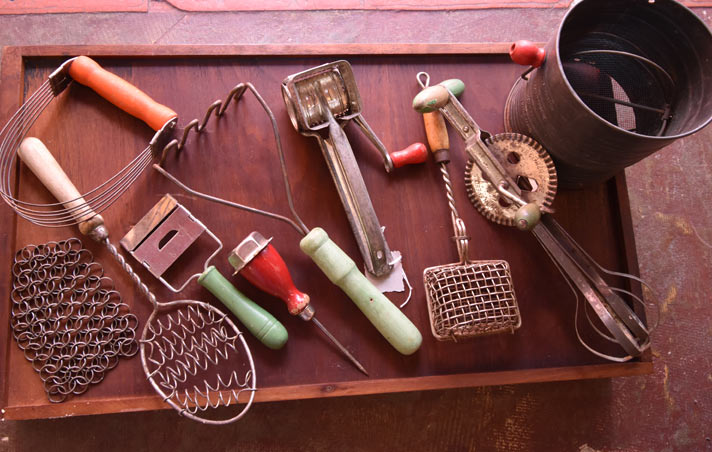Speaking of Antiquing – March 2018
Kitchen utensils are an everyday item that one rarely spends any time thinking about, until you can’t find the one you are looking for.
Kitchen drawers all over America are over-filled with tools one doesn’t necessarily need. I call these “vanity tools.” Do you really need a pincer to remove a strawberry stem when a good finger pinch will do?
Primitive kitchens of the 19th century had tools that were functional. They were handmade by a skilled whittler or carver, forged in a blacksmith shop from iron, pounded from copper, brass, tin, or steel. These were typically hung on the wall near the stove or work table, at the ready.
The 20th century brought graniteware, enamelware, aluminum, and the popularity of painted wooden handles. Color was brought into the kitchen with a lovely green, a bold red, and a neutral white. Functional tools were now pretty and a pleasure to use and display. The hard paint on the handles withstood daily use for many years.
There is a tool for every job, thanks to the mother of invention. If color can be a comfort food, then the green painted handles would be it for me.
Time and use have negated the green of my tools to bare wood, I use them nonetheless. I find an old, unpainted, sturdy potato masher a pleasure to use. When scrambling eggs, I love to use the twisted metal tool with coiled wire wrapped around an oval metal frame. The wrapped wire looks like the coils on an old hot plate, the paint gone, but it has withstood the test of time.
One of my favorite finds came from my in-law’s cavernous cellar. The smooth wooden handle shows no indication of its former color. It has a twisted metal shaft that squares off and is interlaced with metal, woven to form a rigid mesh hinged box. There is a round metal closure that, when pinched, slides down to open. Inside it was a square of chain-mail for scrubbing cast iron. The tool was created to hold the loose tailings of lye soap for swishing in the wash water.
Be aware while collecting wooden-handled tools for your kitchen. The paint on the original items craze and chip over time, and many people have tried to paint the bare wood to restore them, but the paint composition is different now and with a trained eye you will see and feel the difference.
Keep the wooden-handled tools out of the dishwasher, as that will be the end of it. Try not to soak them too long in the sink, as water is the culprit and will cause the old paint to craze and chip.
There is beauty in the silicone and other new materials they now use for kitchen tools. The colors are vibrant and fun to use. I just wonder if they will be collectible in 40 years.
At Pickety Place, our kitchen area has a large selection of primitive and vintage kitchen tools. Many still have their original green or red paint. Some of the tools will leave you wondering for what purpose they were originally intended.

 Margaret Barns is co-owner of Pickety Place Antiques & Collectibles located at 130 N. 4th Street in Jacksonville. LIKE them on
Margaret Barns is co-owner of Pickety Place Antiques & Collectibles located at 130 N. 4th Street in Jacksonville. LIKE them on